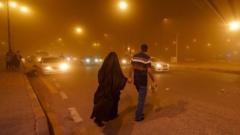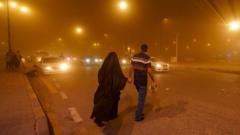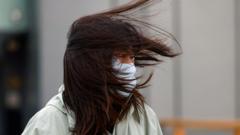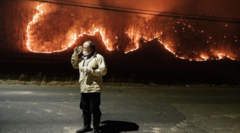A recent sandstorm in Iraq turned the skies orange and resulted in significant health impacts, with thousands suffering respiratory issues. Experts attribute the increasing frequency of such storms to climate change and desertification in the region.
Iraq Faces Severe Sandstorm Crisis as Climate Change Escalates

Iraq Faces Severe Sandstorm Crisis as Climate Change Escalates
A major sandstorm in Iraq has sent thousands to hospitals, exacerbating public health concerns amid worsening climate conditions.
A significant sandstorm has wreaked havoc across central and southern Iraq, transforming the skies into an alarming orange hue and triggering a health crisis. Over the past two days, reduced visibility—down to less than half a mile in some areas—prompted the suspension of flights at two major airports. Thousands found their way to emergency rooms, suffering from respiratory ailments exacerbated by the severe dust storm.
Meteorology officials stated that the storm originated from eastern Saudi Arabia, a predominantly desert region, and picked up additional dust as it swept through southwestern Iraq. While sandstorms have historically occurred in Iraq during the winter and early spring months, experts warn that they are becoming increasingly intense and frequent due to climate change-related factors such as prolonged droughts and the encroachment of desertification.
This storm has been recognized as the most severe in Iraq for 2025, following a similar critical event that disrupted life in Baghdad last December. In 2022, multiple violent sandstorms had already alarmed residents. The United Nations has classified Iraq as the fifth most susceptible nation to climate-related challenges, including extreme heat and decreasing water supplies.
On the day of the storm's peak, southern Iraq faced sweltering temperatures exceeding 100 degrees, only to be alleviated momentarily as the dust storm obscured the sun. With emergency workers and police members forced to work outside, many chose to wear face masks for protection while others covered their mouths with cloths.
The dust infiltrated homes and vehicles alike, coating surfaces and disrupting daily life. The health ministry reported that emergency facilities in southern Iraq treated 3,747 cases of respiratory distress due to the storm. Basra, afflicted intensely during the storm, recorded over 1,000 patients, while Najaf—a smaller city—registered 451 cases. Also affected were residents of Muthanna Province, a region contiguous with Saudi Arabia.
Amid this crisis, local authorities urged families to keep calm as the storm created unsettling noises for young children, ensuring that explanations could help ease their fears and allow them to rest.





















